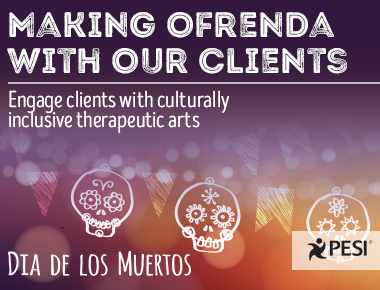Making Ofrenda With Our Clients
Engage clients with culturally inclusive therapeutic arts.

To be done for Day of the Dead or Halloween
From: Multicultural Counseling Workbook: Exercises, Worksheets & Games to Build Rapport with Diverse Clients, By Leslie Korn, PhD
Client Exercise
An ofrenda is a collection of images, objects, and foods that are placed on an altar during the Dia de los Muertos celebration, which is celebrated in Mexico and many other Latin American countries. Ofrendas are created in order to remember and honor deceased loved ones. This is also the original meaning of Halloween. This exercise will show you how to help a client construct his or her own ofrenda as an opportunity to grieve in a culturally congruent manner and to share this process with you as the therapist.
When
While ofrendas are typically made each year on November 2 during Dia de los Muertos, your client can create an altar any time of year.
Who
This exercise can be used with children, with or without a parent or other adult.
Benefits of This Exercise...
Constructing an ofrenda allows for a non-confrontational conversation about death and grief. Ofrenda making also adds in feelings of appreciation and love to the grieving process.
Materials
Small table and tablecloth or fabric
Traditional elements (include any or all):
- Candles (1 for each person being honored)
- Glass of water
- Incense
- Marigolds or other brightly colored flowers (fresh, dried, or paper)
- Favorite foods of the deceased
- Framed photograph of the person being honored
- Personal items of the deceased (jewelry, watch, handkerchief, etc)
Ceramics and woven baskets
Explain to the client that they can make the ofrenda at home or in your office. If they make the ofrenda at home, ask them to take a photograph to show you. This exercise is intended for a client of any culture or background.
Directions
1. Find the proper location for the ofrenda—a small table pushed against a wall is ideal. Cover the table with a piece of fabric or cloth.
2. Place photographs of the deceased in the center of the table. Make sure that each person being honored has a candle.
3. Place personal items of the deceased (jewelry, watch, etc.) on the table. Add candles, incense and incense holder, flowers, foods, glass of water in the front and center of the table.
Next Steps
You may use the different items on the ofrenda to ask questions about those items. Some examples:
- Tell me about your grandmother?
- Tell me about this item and what it means to you?
- What did it mean to your grandmother?
- Are these some foods that she loved?
- Tell me about a time you recall enjoying a meal with her? Or a party?
Conclusion
Engaging in art to elicit and explore feelings is a culturally congruent approach to examining and sharing difficult emotions with people of all ages and within all cultures. All cultures and spiritual practices find ways to express loss and reconnection with loved ones who have passed.
Topic: Diversity
Tags: Day of the Dead | Halloween | Therapeutic Arts




